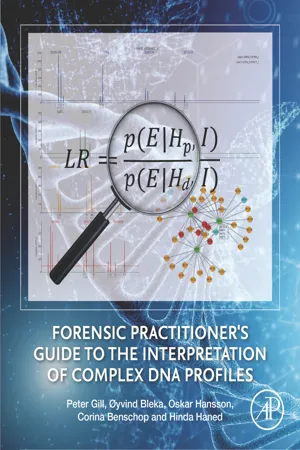
Forensic Practitioner's Guide to the Interpretation of Complex DNA Profiles
- 530 pages
- English
- ePUB (mobile friendly)
- Available on iOS & Android
Forensic Practitioner's Guide to the Interpretation of Complex DNA Profiles
About this book
Over the past twenty years, there's been a gradual shift in the way forensic scientists approach the evaluation of DNA profiling evidence that is taken to court. Many laboratories are now adopting 'probabilistic genotyping' to interpret complex DNA mixtures. However, current practice is very diverse, where a whole range of technologies are used to interpret DNA profiles and the software approaches advocated are commonly used throughout the world.Forensic Practitioner's Guide to the Interpretation of Complex DNA Profiles places the main concepts of DNA profiling into context and fills a niche that is unoccupied in current literature. The book begins with an introduction to basic forensic genetics, covering a brief historical description of the development and harmonization of STR markers and national DNA databases. The laws of statistics are described, along with the likelihood ratio based on Hardy-Weinberg equilibrium and alternative models considering sub-structuring and relatedness. The historical development of low template mixture analysis, theory and practice, is also described, so the reader has a full understanding of rationale and progression. Evaluation of evidence and statement writing is described in detail, along with common pitfalls and their avoidance.The authors have been at the forefront of the revolution, having made substantial contributions to theory and practice over the past two decades. All methods described are open-source and freely available, supported by sets of test-data and links to web-sites with further information. This book is written primarily for the biologist with little or no statistical training. However, sufficient information will also be provided for the experienced statistician. Consequently, the book appeals to a diverse audience- Covers short tandem repeat (STR) analysis, including database searching and massive parallel sequencing (both STRs and SNPs)- Encourages dissemination and understanding of probabilistic genotyping by including practical examples of varying complexity- Written by authors intimately involved with software development, training at international workshops and reporting cases worldwide using the methods described in this book
Frequently asked questions
- Essential is ideal for learners and professionals who enjoy exploring a wide range of subjects. Access the Essential Library with 800,000+ trusted titles and best-sellers across business, personal growth, and the humanities. Includes unlimited reading time and Standard Read Aloud voice.
- Complete: Perfect for advanced learners and researchers needing full, unrestricted access. Unlock 1.4M+ books across hundreds of subjects, including academic and specialized titles. The Complete Plan also includes advanced features like Premium Read Aloud and Research Assistant.
Please note we cannot support devices running on iOS 13 and Android 7 or earlier. Learn more about using the app.
Information
Table of contents
- Cover image
- Title page
- Table of Contents
- Copyright
- About the authors
- Contributors
- Foreword
- Preface
- List of websites and resources
- Chapter 1: Forensic genetics: the basics
- Chapter 2: Empirical characterization of DNA profiles
- Chapter 3: Allele drop-out and the stochastic threshold
- Chapter 4: Low-template DNA
- Chapter 5: LRmix model theory
- Chapter 6: A qualitative (semi-continuous) model: LRmix Studio
- Chapter 7: The quantitative (continuous) model theory
- Chapter 8: EuroForMix
- Chapter 9: Validation
- Chapter 10: Development and implementation of DNAxs
- Chapter 11: Investigative forensic genetics: SmartRank, CaseSolver and DNAmatch2
- Chapter 12: Interpretation, reporting, and communication
- Chapter 13: Interpretation of complex DNA profiles generated by massively parallel sequencing
- Appendix A: Formal descriptions of the genotype probabilities
- Appendix B: Formal description of the probabilistic models
- Bibliography
- Index